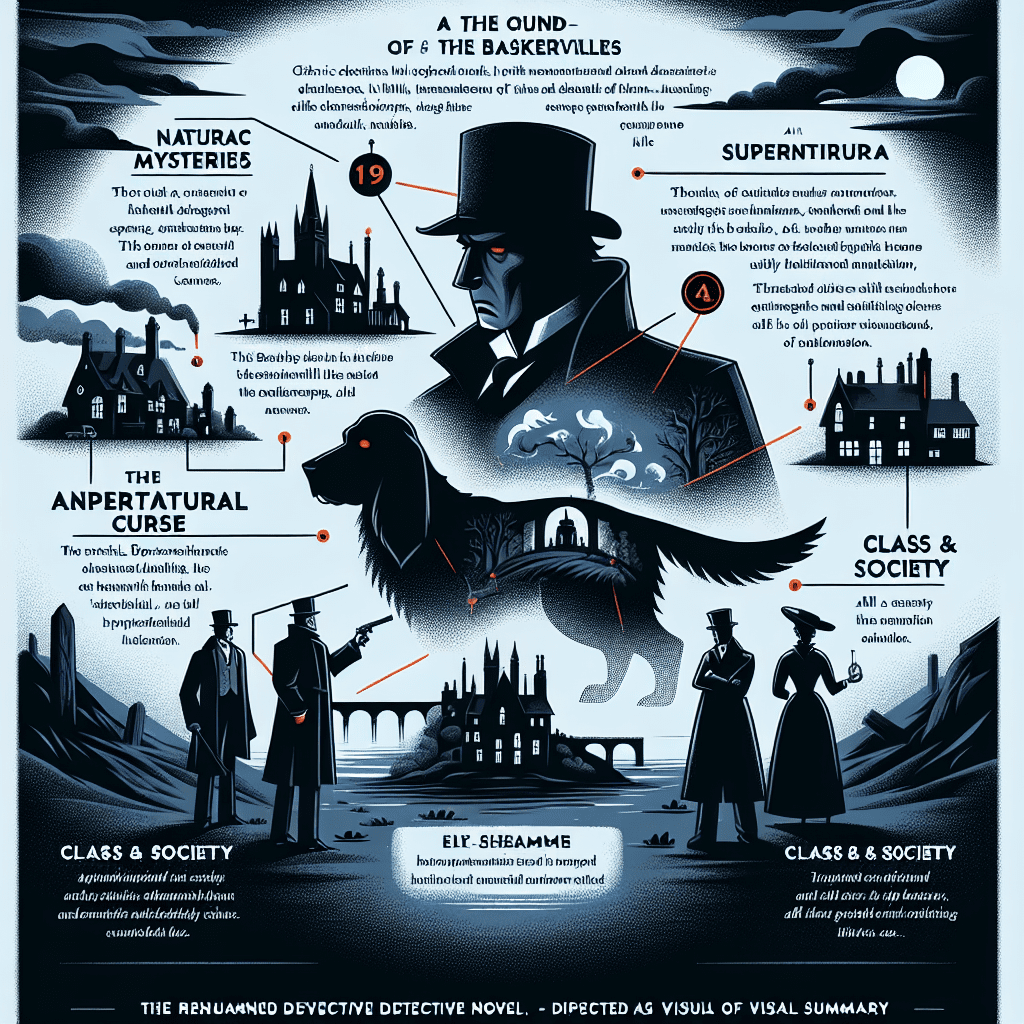-
Table of Contents
- Summary of The Hound of the Baskervilles
- Key Themes in The Hound of the Baskervilles
- Character Analysis of Sherlock Holmes
- The Role of Dr. John Watson in The Hound of the Baskervilles
- The Significance of the Baskerville Family Curse
- The Use of Atmosphere and Setting in The Hound of the Baskervilles
- The Impact of Supernatural Elements on the Plot
- Q&A
“Unravel the mystery of The Hound of the Baskervilles: A chilling tale of fear, loyalty, and the supernatural.”
“The Hound of the Baskervilles,” written by Sir Arthur Conan Doyle, is a classic detective novel featuring the iconic detective Sherlock Holmes and his loyal companion, Dr. John Watson. Set in the eerie moors of Devonshire, the story revolves around the legend of a supernatural hound that haunts the Baskerville family. The narrative begins with the mysterious death of Sir Charles Baskerville, which prompts the investigation into the curse that plagues his lineage. As Holmes and Watson delve deeper into the case, they encounter themes of rationality versus superstition, the nature of evil, and the impact of the past on the present. The novel is populated with memorable characters, including the enigmatic Sherlock Holmes, the steadfast Dr. Watson, the tormented heir Sir Henry Baskerville, and the sinister Jack Stapleton, each contributing to the rich tapestry of suspense and intrigue that defines this enduring work.
Summary of The Hound of the Baskervilles
“The Hound of the Baskervilles,” a novel by Sir Arthur Conan Doyle, is one of the most celebrated works featuring the iconic detective Sherlock Holmes. Set in the eerie moors of Devonshire, the narrative unfolds as a gripping mystery that intertwines elements of the supernatural with the rationality of detective work. The story begins with Dr. John Watson, Holmes’s loyal companion, who recounts the chilling legend of the Baskerville family. According to local lore, a monstrous hound haunts the Baskerville lineage, having been responsible for the death of Sir Charles Baskerville, the latest heir to the estate. This legend sets the stage for the investigation that follows.
When Sir Charles is found dead under mysterious circumstances, his friend Dr. Mortimer seeks Holmes’s expertise to unravel the truth behind the legend and the circumstances of the death. Mortimer presents Holmes with a manuscript detailing the Baskerville curse, which piques Holmes’s interest. He agrees to take on the case, and the two set off to Baskerville Hall, where they are met with an atmosphere thick with tension and superstition. As they delve deeper into the investigation, they encounter a cast of intriguing characters, including the enigmatic Sir Henry Baskerville, who has recently returned from Canada to claim his inheritance.
As the plot progresses, Holmes and Watson uncover a series of clues that lead them to suspect that Sir Charles’s death was not merely the result of a heart attack, as initially believed, but rather a calculated murder. The moor itself becomes a character in the story, with its desolate beauty and treacherous terrain adding to the sense of foreboding. The duo’s investigation reveals a web of deceit, jealousy, and hidden motives among the residents of the moor, including the sinister figure of Jack Stapleton, who has his own designs on the Baskerville estate.
The tension escalates as Holmes and Watson race against time to protect Sir Henry from the same fate as his predecessor. The legendary hound, described as a spectral creature with glowing eyes and a fearsome howl, looms large in the narrative, embodying the fears and superstitions of the local populace. However, as Holmes meticulously pieces together the evidence, it becomes clear that the true threat is not a supernatural beast but rather the machinations of a human antagonist. The climax of the story culminates in a dramatic confrontation on the moors, where the truth about the hound and the identity of the murderer are finally revealed.
In the end, “The Hound of the Baskervilles” serves not only as a thrilling detective story but also as a commentary on the clash between rationality and superstition. The novel explores themes of fear, loyalty, and the nature of evil, all while showcasing Holmes’s unparalleled deductive skills. The resolution of the mystery reinforces the idea that while legends may hold a kernel of truth, it is through reason and investigation that one can uncover the reality hidden beneath layers of myth. Ultimately, Conan Doyle’s masterful storytelling and rich character development ensure that “The Hound of the Baskervilles” remains a timeless classic, captivating readers with its blend of suspense and intellectual challenge.
Key Themes in The Hound of the Baskervilles
In Arthur Conan Doyle’s “The Hound of the Baskervilles,” several key themes intertwine to create a rich tapestry that enhances the narrative and deepens the reader’s engagement with the text. One of the most prominent themes is the conflict between rationality and superstition. Set against the backdrop of the eerie moors of Devonshire, the story revolves around the legend of a supernatural hound that haunts the Baskerville family. While the local populace is steeped in fear and superstition regarding the hound, Sherlock Holmes embodies the principles of logic and reason. His methodical approach to solving the mystery serves as a counterpoint to the irrational beliefs held by the villagers, illustrating the tension between scientific inquiry and the allure of the supernatural.
Moreover, the theme of isolation plays a significant role in shaping the atmosphere of the novel. The desolate moors, with their vast expanses and treacherous terrain, create a sense of seclusion that mirrors the emotional states of the characters. Sir Henry Baskerville, the heir to the Baskerville estate, finds himself increasingly isolated as he grapples with the legacy of his family’s curse. This physical and psychological isolation amplifies the sense of danger and foreboding that permeates the narrative. As Holmes and Watson navigate the treacherous landscape, their journey becomes not only a quest for truth but also a reflection on the human condition, emphasizing how isolation can lead to vulnerability and fear.
In addition to isolation, the theme of loyalty and friendship emerges prominently through the relationship between Holmes and Watson. Their partnership is characterized by mutual respect and unwavering support, which is particularly evident as they confront the dangers posed by the hound. Watson’s loyalty to Holmes is unwavering, and he serves as both a confidant and a chronicler of their adventures. This theme of camaraderie underscores the importance of trust and collaboration in overcoming adversity, suggesting that even in the face of overwhelming odds, the bonds of friendship can provide strength and resilience.
Another significant theme is the exploration of identity and legacy. The Baskerville family is haunted not only by the legend of the hound but also by the weight of their ancestral history. Sir Charles Baskerville’s mysterious death and the subsequent events surrounding Sir Henry’s arrival at the estate prompt an examination of how the past shapes the present. The characters grapple with their identities in relation to their lineage, and the novel raises questions about the extent to which one can escape the shadows of their heritage. This theme resonates with readers as it reflects broader concerns about the influence of family history on individual choices and destinies.
Finally, the theme of nature versus nurture is subtly woven throughout the narrative. The moors, with their wild and untamed beauty, serve as a backdrop for the unfolding drama, suggesting that the environment can shape behavior and influence outcomes. The hound itself, a creature of both myth and reality, embodies the primal instincts that lie within humanity. As Holmes investigates the case, he confronts not only the external forces at play but also the internal struggles of the characters, highlighting the complex interplay between inherited traits and personal choices.
In conclusion, “The Hound of the Baskervilles” is a multifaceted work that delves into themes of rationality versus superstition, isolation, loyalty, identity, and the nature versus nurture debate. These themes not only enrich the narrative but also invite readers to reflect on their own beliefs and experiences, making the novel a timeless exploration of the human experience.
Character Analysis of Sherlock Holmes
In Arthur Conan Doyle’s “The Hound of the Baskervilles,” Sherlock Holmes emerges as a quintessential detective, embodying the characteristics that have made him an enduring figure in literature. His analytical prowess and keen observational skills are central to the narrative, allowing him to unravel the mystery surrounding the legendary hound that haunts the Baskerville family. Holmes’s character is marked by a combination of intellect, rationality, and a certain aloofness, which sets him apart from the other characters in the novel.
Holmes’s methodical approach to solving crimes is evident throughout the story. He relies heavily on empirical evidence and logical reasoning, often dismissing supernatural explanations in favor of more plausible, earthly ones. This is particularly significant in “The Hound of the Baskervilles,” where the legend of a ghostly hound threatens to overshadow the investigation. Holmes’s skepticism regarding the supernatural elements of the case reflects his commitment to rational thought, as he seeks to uncover the truth behind the myth. His famous declaration that “when you have eliminated the impossible, whatever remains, however improbable, must be the truth” encapsulates his investigative philosophy and serves as a guiding principle throughout the narrative.
Moreover, Holmes’s character is defined by his exceptional attention to detail. He possesses an uncanny ability to notice the minutiae that others overlook, which often leads him to crucial insights. For instance, his examination of Sir Charles Baskerville’s footprints and the peculiarities of the surrounding environment reveals vital clues that contribute to the unraveling of the mystery. This meticulous nature not only highlights his intellectual capabilities but also underscores the theme of observation versus perception, as characters like Dr. Watson often fail to see what is right in front of them.
In addition to his intellectual attributes, Holmes’s personality is marked by a certain detachment. He often appears emotionally distant, prioritizing logic over sentiment. This characteristic can be seen in his interactions with Dr. Watson, where he frequently assumes a superior position, treating Watson more as a companion and assistant than an equal. While this dynamic can create tension, it also serves to emphasize Holmes’s singular focus on his work. His occasional moments of camaraderie with Watson reveal a deeper layer to his character, suggesting that beneath the stoic exterior lies a profound appreciation for friendship and loyalty.
Furthermore, Holmes’s character is enriched by his occasional displays of arrogance and self-assuredness. He is confident in his abilities, sometimes to the point of dismissing the contributions of others. This trait can be both a strength and a weakness, as it drives him to pursue the truth relentlessly but can also alienate those around him. Nevertheless, his unwavering commitment to justice and the pursuit of knowledge ultimately positions him as a heroic figure, one who seeks to protect the innocent and uphold the law.
In conclusion, Sherlock Holmes in “The Hound of the Baskervilles” is a complex character whose analytical mind, attention to detail, emotional detachment, and occasional arrogance contribute to his role as a master detective. His unwavering commitment to rationality and truth serves as a counterpoint to the supernatural elements of the story, reinforcing the novel’s themes of reason versus superstition. Through Holmes, Conan Doyle crafts a character that not only captivates readers but also invites them to engage with the intricacies of deduction and the nature of human understanding.
The Role of Dr. John Watson in The Hound of the Baskervilles
In Arthur Conan Doyle’s “The Hound of the Baskervilles,” Dr. John Watson plays a pivotal role that extends beyond mere companionship to Sherlock Holmes; he serves as the narrative’s anchor and a lens through which the reader experiences the unfolding mystery. As Holmes’s trusted friend and confidant, Watson embodies the qualities of loyalty, intelligence, and courage, which are essential in navigating the eerie and treacherous landscape of the moors. His character is not only a foil to Holmes’s brilliant deductive reasoning but also a vital participant in the investigation of the Baskerville curse.
From the outset, Watson is portrayed as a diligent and observant individual, qualities that are crucial in his role as the narrator of the story. While Holmes often operates in the shadows, relying on his acute intellect and unconventional methods, Watson provides a more grounded perspective. This contrast is particularly evident in the way Watson approaches the mystery surrounding Sir Charles Baskerville’s death and the legend of the supernatural hound. His initial skepticism about the supernatural elements of the case reflects a rational mindset, which serves to balance Holmes’s more eccentric inclinations. As the story progresses, Watson’s observations and insights become increasingly significant, allowing readers to engage with the narrative on a deeper level.
Moreover, Watson’s role as the primary investigator in Holmes’s absence highlights his capabilities as a detective in his own right. When Holmes is preoccupied with other matters, Watson takes it upon himself to gather information and piece together clues. His journey to Baskerville Hall, where he encounters the eerie atmosphere and the various characters tied to the Baskerville legacy, showcases his resourcefulness and determination. Through his detailed accounts, readers gain a vivid sense of the setting and the mounting tension surrounding the case. Watson’s ability to articulate his experiences not only enhances the narrative but also invites readers to share in the suspense and intrigue.
In addition to his investigative prowess, Watson’s character also embodies the theme of friendship and loyalty. His unwavering support for Holmes, even when faced with danger, underscores the deep bond between the two men. This loyalty is particularly evident when Watson expresses concern for Holmes’s safety and well-being, demonstrating that their relationship transcends mere professional collaboration. Watson’s admiration for Holmes’s intellect is palpable, yet he also exhibits a sense of independence, as he is not afraid to challenge Holmes’s conclusions when necessary. This dynamic adds depth to their partnership, illustrating that while Holmes may be the genius, Watson is an indispensable ally.
Furthermore, Watson’s interactions with other characters, such as Sir Henry Baskerville and Miss Stapleton, reveal his empathetic nature. He approaches each individual with a sense of understanding, which allows him to uncover vital information that contributes to the investigation. His ability to connect with others highlights the importance of human relationships in the face of fear and uncertainty, reinforcing the notion that collaboration is essential in overcoming challenges.
In conclusion, Dr. John Watson’s role in “The Hound of the Baskervilles” is multifaceted, encompassing the duties of a loyal friend, a capable investigator, and a relatable narrator. His character not only complements Holmes’s brilliance but also enriches the narrative by providing a human touch to the chilling tale. Through Watson’s eyes, readers are drawn into the mystery, experiencing the tension and excitement of the investigation while also appreciating the enduring themes of friendship and loyalty that underpin the story.
The Significance of the Baskerville Family Curse
In Arthur Conan Doyle’s “The Hound of the Baskervilles,” the curse of the Baskerville family serves as a pivotal element that intertwines the narrative’s supernatural and rational components. This curse, which is said to have been placed upon the Baskerville lineage by a vengeful ancestor, Sir Hugo Baskerville, establishes a haunting backdrop that influences the characters and drives the plot. The legend of the monstrous hound, a spectral creature that is believed to hunt down members of the Baskerville family, not only instills fear but also raises questions about the nature of fate and the impact of ancestral sins.
The significance of the Baskerville family curse extends beyond mere superstition; it reflects the themes of guilt and retribution that permeate the novel. The curse symbolizes the weight of the past, suggesting that the actions of previous generations can have dire consequences for their descendants. This notion is particularly relevant to Sir Charles Baskerville, whose untimely death is shrouded in mystery and linked to the curse. His demise serves as a catalyst for the investigation led by Sherlock Holmes and Dr. John Watson, highlighting how the past continues to haunt the present. As the characters delve deeper into the mystery, they confront not only the physical threat posed by the hound but also the psychological burden of their family’s history.
Moreover, the curse embodies the tension between rationality and superstition, a central theme in the narrative. While Holmes represents the epitome of logic and scientific reasoning, the legend of the hound evokes a primal fear that challenges his analytical approach. This dichotomy is crucial, as it illustrates the struggle between enlightenment and ignorance, a reflection of the broader societal shifts occurring during the Victorian era. The characters’ varying responses to the curse reveal their individual beliefs and fears, further enriching the narrative. For instance, Dr. Watson, who initially approaches the case with skepticism, gradually becomes more attuned to the eerie atmosphere of the moors, suggesting that even the most rational minds can be swayed by the inexplicable.
Additionally, the curse serves as a narrative device that propels the story forward, creating suspense and intrigue. The legend of the hound not only captivates the characters but also engages the reader, inviting them to explore the intersection of myth and reality. As Holmes investigates the circumstances surrounding Sir Charles’s death, the curse looms large, casting doubt on the motives of those involved and complicating the quest for truth. The gradual unraveling of the mystery reveals how deeply entrenched the curse is within the Baskerville legacy, ultimately leading to a confrontation with the very forces that have haunted the family for generations.
In conclusion, the significance of the Baskerville family curse in “The Hound of the Baskervilles” lies in its multifaceted role within the narrative. It serves as a symbol of ancestral guilt, a catalyst for character development, and a source of tension between rationality and superstition. Through the exploration of this curse, Conan Doyle not only crafts a compelling mystery but also invites readers to reflect on the enduring impact of the past on the present. The interplay between the supernatural and the rational ultimately enriches the story, making it a timeless exploration of fear, legacy, and the human condition.
The Use of Atmosphere and Setting in The Hound of the Baskervilles
In Arthur Conan Doyle’s “The Hound of the Baskervilles,” the atmosphere and setting play a crucial role in shaping the narrative and enhancing the themes of mystery and suspense. Set against the backdrop of the desolate moors of Devonshire, the novel immerses readers in a landscape that is as much a character as the individuals who inhabit it. The eerie and foreboding environment contributes significantly to the overall tone of the story, creating a palpable sense of dread that permeates the plot.
From the outset, the moors are depicted as a wild and untamed expanse, characterized by their isolation and unpredictability. This setting serves to heighten the tension, as the vastness of the landscape mirrors the characters’ feelings of vulnerability and fear. The fog that often envelops the moors adds an element of uncertainty, obscuring visibility and creating an atmosphere ripe for supernatural occurrences. As Sherlock Holmes and Dr. Watson navigate this treacherous terrain, the reader is acutely aware of the dangers that lurk within the shadows, reinforcing the novel’s central themes of fear and the unknown.
Moreover, the Baskerville estate itself, with its imposing architecture and haunting history, further amplifies the novel’s atmosphere. The ancestral home of the Baskerville family is steeped in legend and tragedy, serving as a physical manifestation of the family’s cursed legacy. The descriptions of the estate evoke a sense of decay and foreboding, with its dark corridors and hidden secrets. This setting not only reflects the psychological states of the characters but also acts as a catalyst for the unfolding mystery. The interplay between the characters and their environment underscores the idea that the past is inextricably linked to the present, a theme that resonates throughout the narrative.
As the story progresses, the atmosphere becomes increasingly charged with tension, particularly as the legend of the hound is introduced. The supernatural elements associated with the hound are intricately woven into the fabric of the moors, blurring the lines between reality and myth. This ambiguity serves to heighten the suspense, as characters grapple with their beliefs in the rational versus the irrational. The setting thus becomes a reflection of the characters’ internal struggles, particularly for Watson, who is torn between his loyalty to Holmes and his own instincts as he confronts the chilling tales surrounding the Baskerville curse.
In addition to enhancing the mood, the atmospheric elements in “The Hound of the Baskervilles” also serve to explore broader themes of rationality and superstition. Holmes, as the embodiment of logic and reason, stands in stark contrast to the eerie legends that permeate the moors. His methodical approach to solving the mystery highlights the tension between scientific inquiry and the allure of the supernatural. This dichotomy is further emphasized by Watson’s experiences on the moors, where he is often caught between his rational mind and the primal fears evoked by the setting.
Ultimately, the use of atmosphere and setting in “The Hound of the Baskervilles” is integral to the novel’s impact. The moors and the Baskerville estate not only create a vivid backdrop for the unfolding drama but also serve as a reflection of the characters’ inner turmoil and the thematic complexities of the narrative. Through this masterful interplay of environment and emotion, Conan Doyle crafts a tale that resonates with readers, inviting them to explore the depths of fear, mystery, and the human psyche.
The Impact of Supernatural Elements on the Plot
In Arthur Conan Doyle’s “The Hound of the Baskervilles,” the interplay of supernatural elements significantly shapes the narrative, creating an atmosphere of suspense and intrigue that captivates readers. From the outset, the legend of the spectral hound looms large over the story, serving as both a catalyst for the plot and a reflection of the characters’ fears. The tale begins with the ominous death of Sir Charles Baskerville, whose demise is attributed to the terrifying presence of a ghostly hound that has haunted the Baskerville family for generations. This legend not only sets the stage for the ensuing investigation but also introduces a sense of dread that permeates the novel.
As Sherlock Holmes and Dr. Watson delve deeper into the mystery, the supernatural elements serve to heighten the tension and complicate their quest for truth. The hound, described as a monstrous creature with glowing eyes and a fearsome howl, embodies the primal fears of the characters and the local community. This fear is palpable, as the villagers are quick to attribute unexplained occurrences to the supernatural, illustrating how folklore can shape perceptions and influence behavior. The legend of the hound becomes a character in its own right, casting a long shadow over the Baskerville estate and instilling a sense of foreboding that propels the narrative forward.
Moreover, the supernatural elements in the novel are intricately tied to the themes of rationality versus superstition. Holmes, the epitome of logic and reason, approaches the case with a scientific mindset, seeking to unravel the mystery through empirical evidence and deductive reasoning. In contrast, the local inhabitants are steeped in superstition, often allowing their beliefs in the supernatural to cloud their judgment. This dichotomy between rational thought and irrational fear is a recurring theme throughout the story, as Holmes’s methodical investigation gradually reveals the truth behind the legend. The tension between these opposing forces not only drives the plot but also invites readers to consider the nature of belief and the impact of folklore on human behavior.
As the investigation unfolds, the supernatural elements also serve to explore the psychological dimensions of fear. The characters’ responses to the legend of the hound reveal their vulnerabilities and insecurities. For instance, Sir Henry Baskerville, the heir to the Baskerville estate, grapples with the weight of his family’s cursed history, while Watson, though initially skeptical, finds himself increasingly influenced by the eerie atmosphere of the moors. This psychological interplay underscores the idea that fear can be as potent as any tangible threat, shaping actions and decisions in profound ways.
Ultimately, the resolution of the mystery reveals that the supernatural elements, while initially appearing to be central to the plot, are intricately woven into a more complex narrative about human nature and the power of belief. The hound, it turns out, is not a supernatural entity but rather a product of human manipulation, illustrating how fear can be exploited for personal gain. This revelation reinforces the theme that the true monsters often lie within humanity itself, rather than in the realm of the supernatural. In this way, “The Hound of the Baskervilles” masterfully intertwines elements of the supernatural with a deeper exploration of human psychology, making it a timeless tale that continues to resonate with readers.
Q&A
1. **What is the main plot of “The Hound of the Baskervilles”?**
The novel follows Sherlock Holmes and Dr. John Watson as they investigate the mysterious death of Sir Charles Baskerville, believed to be caused by a supernatural hound that haunts the Baskerville family.
2. **Who are the main characters in the novel?**
The main characters include Sherlock Holmes, Dr. John Watson, Sir Henry Baskerville, and the villainous Jack Stapleton.
3. **What are the key themes in “The Hound of the Baskervilles”?**
Key themes include the conflict between reason and superstition, the nature of evil, and the impact of isolation and environment on human behavior.
4. **How does the setting influence the story?**
The moorland setting creates an atmosphere of mystery and danger, enhancing the gothic elements of the story and reflecting the characters’ emotional states.
5. **What role does the supernatural play in the novel?**
The supernatural is a central element, as the legend of the ghostly hound creates tension and fear, but ultimately, it is revealed to have a rational explanation.
6. **What is the significance of the character of Dr. Watson?**
Dr. Watson serves as the narrator and a foil to Holmes, providing a relatable perspective for readers and showcasing the detective’s brilliance through his observations.
7. **How does the novel conclude?**
The mystery is resolved when Holmes and Watson uncover the truth behind the hound, revealing that it was a trained dog used by Jack Stapleton to scare Sir Charles and Sir Henry, leading to their deaths.”The Hound of the Baskervilles” is a classic detective novel by Arthur Conan Doyle that follows Sherlock Holmes and Dr. John Watson as they investigate the mysterious death of Sir Charles Baskerville, believed to be linked to a legendary supernatural hound. The novel explores themes of rationality versus superstition, the impact of the past on the present, and the nature of fear. Key characters include the logical and observant Sherlock Holmes, the loyal and brave Dr. Watson, and the tormented heir, Sir Henry Baskerville. Ultimately, the story combines elements of mystery, horror, and adventure, showcasing Conan Doyle’s mastery in weaving a compelling narrative that challenges the boundaries between reality and myth.




